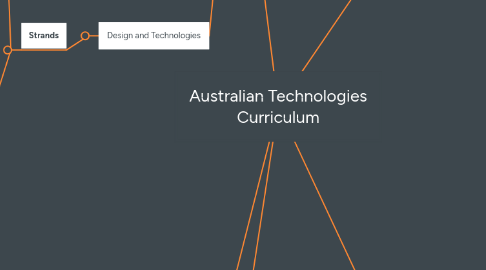
1. Subjects
1.1. Digital Technologies
1.1.1. Strands
1.1.1.1. Digital Technologies Process and Production Skills
1.1.1.1.1. Create ideas and information
1.1.1.1.2. Digital solutions
1.1.1.1.3. Evaluate solutions and existing information
1.1.1.2. Digitals Technologies Knowledge and Understanding
1.1.1.2.1. data
1.1.1.2.2. digital systems
1.1.1.2.3. Hardware,software and networks
1.2. Design and Technologies
1.2.1. Strands
1.2.1.1. Design and Technologies Process and Production Skills
1.2.1.1.1. Investigating and defining
1.2.1.1.2. Designing
1.2.1.1.3. Producing and Implementing
1.2.1.1.4. Evaluating
1.2.1.1.5. Collaboration and Managing
1.2.1.2. Design and Technologies Knowledge and Understanding
1.2.1.2.1. Use of Technology and design
1.2.1.2.2. Development of Technology and Design
1.2.1.2.3. Impact of Technology and Design
1.2.1.2.4. Range of Contexts
2. Key Concepts/Ideas
2.1. Creating Preferred Futures
2.1.1. Project Management
2.1.2. Thinking in Technologies
2.1.2.1. Systems thinking
2.1.2.1.1. Make connections between solutions
2.1.2.1.2. Holistic approach
2.1.2.1.3. Thinking in a loop
2.1.2.1.4. Structure determines behaviour
2.1.2.2. Design Thinking
2.1.2.2.1. Research
2.1.2.2.2. Innovation
2.1.2.2.3. Creativity
2.1.2.2.4. Problem Solving
2.1.2.3. Computational Thinking
2.1.2.3.1. Problem solving method
2.1.2.3.2. Implemented by digital Systems
2.1.2.3.3. Organising data
2.1.2.3.4. Breaking problems into parts
2.1.2.3.5. Define abstract concepts
2.1.2.3.6. Models
2.1.2.3.7. Types
2.1.3. Information and Communication Technology in the Australian Curriculum
2.1.4. Safety
2.1.4.1. Digital citizenship
2.1.4.1.1. Engage positively
2.1.4.1.2. Know your online world
2.1.4.1.3. Choose consciously
2.1.5. Animal Ethics
3. General Capabilities
3.1. Numeracy
3.2. Critical and Creative Thinking
3.3. Ethical Understanding
3.4. Literacy
3.5. Information and Communication Technology Capability
3.6. Personal and Social Capability
3.7. Intercultural Understanding
4. Curriculum Aims and Objectives
4.1. Develop confident, critical technology users
4.2. create designers and producers of designed solutions
4.3. investigate, analyse,and develop innovative and ethical design solutions
4.3.1. sustainable futures
4.4. design and systems thinking
4.5. generate and communicate ideas
4.5.1. Work independently
4.5.2. Work collaboratively
4.6. rage of contexts
4.6.1. Manipulate materials
4.6.2. Select materials
4.7. Safety
4.8. Managing Process
4.9. Transfer knowledge and skills
4.9.1. Peer teaching
4.9.2. School community
4.9.3. Global community
4.10. Understand roles and responsibilities
4.10.1. Contributions to society
4.10.2. Careers
4.10.3. Create decision makers
4.11. Ethical,legal, aesthetic and functional factors
4.11.1. Economic impact
4.11.2. Social Impact
4.11.3. Environmental Impact
4.12. Engaging
4.12.1. Experimental activities
4.12.2. Real world context
4.12.3. Hands on
4.12.4. Practical application
4.12.5. Range of learning experiences
4.12.6. Creativity
5. Cross-Curriculum Priorities
5.1. Asia and Australia Engagement with Asia
5.1.1. Diversity
5.1.1.1. Environments
5.1.1.2. Lifestyle
5.1.1.3. Traditions
5.1.1.4. Culture
5.1.2. Achievements and contributions
5.1.2.1. Past
5.1.2.2. Contining
5.1.2.3. Acknowledges influence
5.1.3. Asia-Ausralia engagement
5.1.3.1. Active engagement
5.1.3.2. Effective engagement
5.2. Aboriginal and Torres Strait Islander Histories and Culture
5.2.1. See there culture reflected in the curriculum
5.2.2. Fully participate in the curriculum
5.2.3. Build self esteem
5.2.4. Engage in reconciliation
5.2.4.1. Respect
5.2.4.2. Recognition
5.3. Sustainability
5.3.1. Interaction of environemnts
5.3.1.1. Dynamic systems
5.3.2. Appreciate and respect diversity of views
5.3.2.1. World views
5.3.2.2. Values and Social Justice
5.3.2.3. Community action
5.3.3. Critical and creative participation to determine solutions
5.3.3.1. Promote reflective thinking
5.3.3.2. Empower to take action
5.3.3.3. Improved futures
